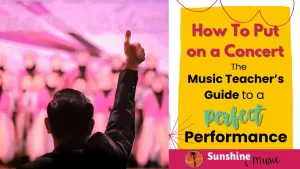Welcome to Getting Started With Gordon, a series for people interested in learning more about Music Learning Theory and how they might apply it in their classroom. Last week we looked at how MLT meshes well with what you are already doing in your classroom and what unique things it can offer.
Getting Started With Gordon: Overview
Two important points before we start today’s topic:
- For better information on all topics covered here, check out giml.org. This is the official site and they know much more than I do.
- Why should I incorporate MLT in my teaching? MLT is a body of research that explain how kids learn music and how to best teach it to them for maximum understanding. And it fits with what you already do in class, just you will know why you are doing it, and when to do it. I don’t know about you, but I think that is a super helpful thing to know!
Speaking a Musical Language
Research has found that students learn music much like they learn language. Based on this, there are 5 levels of musical understanding. Today we will delve deeper into what those would look like in a music classroom. Specifically, we will be looking at the first three, which deal with singing and listening and no written notation. As a side note, as I teach each of these things, I would isolate the skill and teach it specifically, but I would also just pop things in to the middle of songs that I am teaching.
Level 1 – Aural/Oral
This is a listen/sing/say level. Everything is on a neutral syllable. I guess if I were to compare this with language, I would say this is like when a baby accurately matches the sounds or gestures you do. This is the stage where you are trying to get students to imitate with accuracy.
RHYTHM: tapping or playing the steady beat, echo rhythms on a neutral syllable, echo rhythms on an instrument, tapping/moving to the big and little beat, create a different rhythm than the teacher (either through body percussion, percussion, or chanting on a neutral syllable)
TONAL: echo melodic patterns on a neutral syllable, sing the resting tone (tonal center) on a neutral syllable, playing patterns on instruments (although I save a lot of this for later when we get in to labeling. I tend to stick with simple things like tremolos), create a different pattern than the teacher through singing or playing
Level 2 – Verbal Association
This is when we start to label everything we already learned. In language, this would be where you start putting words to objects.
RHYTHM: move to the big and little beat while chanting rhythm syllables (TA/TI TI or DU/DU-DE), echo rhythms with syllables, label duple and triple meter (with teacher help), teacher says a pattern without syllables and students say it back with syllables, improvise a pattern using rhythm syllables
TONAL: echo tonal patterns with solfege, sing the resting tone on solfege, determine tonic and dominant patterns, sing a pattern (neutral) and students sing it back with solfege, label major and minor tonality (with teacher help)
Partial Synthesis
This where those melodic and rhythmic patterns you’ve been teaching are understood in context. In terms of language, this where words would be combined to create sentences. In music, it is where students can analyze and improvise because they understand the context of the meter and tonality.
RHYTHM: chanting a group of patterns without syllables – students determine if it is duple or triple meter based on what syllables they are audiating in their head
TONAL: singing a group of notes without syllables – students determine if it is major or minor tonality based on what solfege they are audiating in their head
And that is it for this week. Next week, I give you a sample lesson with a common song and show you what it would look like at each level. Then, we will delve into the last two levels, which deal with written notation.







0 Responses